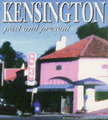




The best source of historical information about Kensington is provided in the book Kensington: Past & Present, written by the Kensington Improvement Club and published by Woodford Press. All the information provided below came from this source.
Between 1900 and 1925 Kensington was still a largely undeveloped grassy hillside covered with dairy farms and adjoining pasture land. Primary residential development began in the early 1900s. In 1911 one of the original surveyors named the area Kensington after the London borough where he lived, South Kensington, England. Kensington's boundaries were first defined in 1917 when El Cerrito was Incorporated. A dispute errupted because the Kensington farmers and dairymen had no desire to pay taxes to finance city improvements they would rarely use. Eventually the supervisors drew the boundaries of the proposed city of El Cerrito to exclude areas where there was strong opposition. Thus, Kensington was born, evolved from the seeds of protest, its boundaries drawn by exclusion rather than inclusion. In 1920 the population of Kensington was 226 and by 1930 the population had grown to nearly 1500. Kensington owes its initial growth in population to two major disasters. The San Francisco Earthquake and Fire of 1906, and later, the Berkeley Fire of 1923. These disasters prompted displaced residents to look to Kensington for housing alternatives. Through the years and population growth, Kensington has retained a quiet charm which its residents find quite appealing. The magnificent views of the Golden Gate bridge and the San Francisco Bay provide one of the more obvious appeals — but the sense of community is another.
Read more about Kensington in ...
 Kensington: Past and Present By the Kensington Improvement Club © 2000 Woodford Press |
Government | Community | Kids' Services | Health Care
Cool Places | History | Nearby Towns
Home Sales | Photo Gallery | Featured Business
Contact Us | Advertise | Support aboutKensington